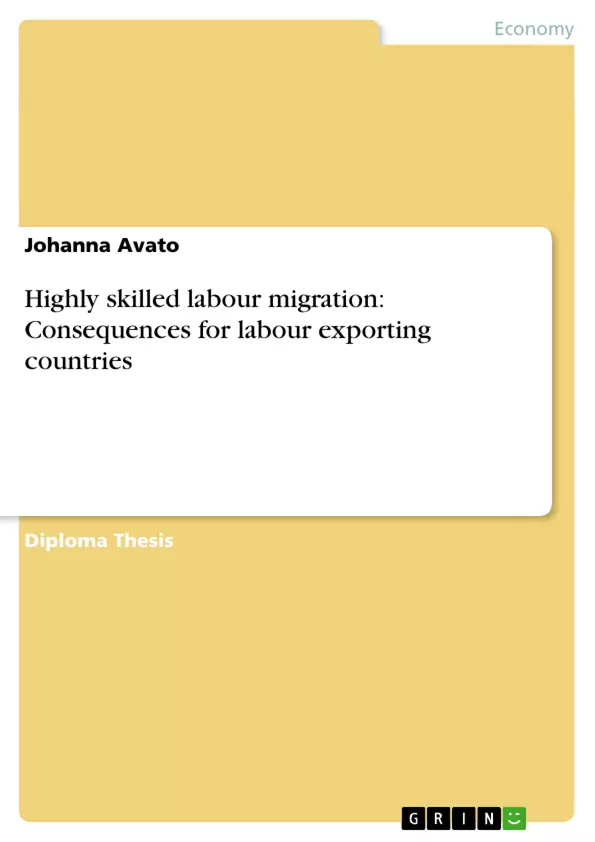The emigration of highly skilled people, the so-called brain drain (BD) has prompted a significant amount of literature, and suggestions about consequences of high skilled mobility for sending countries (SCs) are numerous but rather ambiguous. Historically, two major approaches can be distinguished. A negative view of the detrimental consequences for SCs due to the loss of human capital, and hence an increasing inequality among least developed countries (LDCs) and developed (DCs) (SCs and receiving countries (RCs)) characterised the discussion in the 1960s and 1970s. This view was intensified by the end of the 1980s, as the new growth theory stressed the importance of human capital as the main driver of economic growth. Accordingly, the loss of human capital would deprive SCs of a major prerequisite for growth and permanently hamper development. Lately, however, this pessimistic vision of accentuating the disadvantages for growth in SCs has been challenged by a more positive point of view. Expatriates are not seen as a loss anymore but instead as a resource which can be employed in favour of the SC. Rather pragmatically, this transnational view admits that, as long as incentives such as inequalities in many areas persist, highly skilled migrants cannot be hindered from moving. Therefore, newer theories focus on the advantages that SCs can draw from linking to their diaspora. Indeed, following this theory, SCs can seize numerous opportunities to manage international migration to offset its inevitable disadvantages, thus effectively turning the brain drain into a brain gain.
It will be the aim of this paper to analyse whether the more recent view of international mobility of highly skilled workers can really countervail the concerns typical of the more traditional view. Will the LDCs be able to benefit from their expatriate HC or will migration enlarge disparities between SCs and RCs and consequently increase emigration even further? To address this question the following parts will give an overview on migration flows, present the underlying theories of the different approaches and assess existing empirical findings on the impact of the BD. Finally, policy implications will be outlined before concluding the paper.
Inhaltsverzeichnis (Table of Contents)
- General Theories of International Migration
- Introduction
- Trends in International Migration
- Microeconomic Approaches
- Macroeconomic Approaches
- Theories of International Highly Skilled Labour Migration
- Dynamics of Highly Skilled Labour Migration
- The Case of Highly Skilled Migrants
- Critical Mass Dynamics
- Effects of the Brain Drain – The Traditional View
- Static Effects
- Dynamic Effects
- Effects on Development
- Effects on Growth
- Effects of the Brain Drain - Recent Developments
- The Optimal Brain Drain
- The Feedback Effects
- The Diaspora
- Remittances
- Return
- Technology Transfer
- How Big is the Brain Drain - Empirical Evidence
- Effects of the Brain Drain: The Empirical Analysis
- Critical Mass
- Static Effects
- The Optimal Brain Drain
- The Feedback Effects
- The Diaspora
- Remittances
- Return
- Technology Transfer
- Policy Responses to High Skilled Migration
- Immigration Policies
- Mobilising the Diaspora
- Retention
- Conclusion
Zielsetzung und Themenschwerpunkte (Objectives and Key Themes)
This paper analyzes the consequences of highly skilled labor migration for developing countries, particularly focusing on the phenomenon known as the brain drain. It explores the traditional view of the brain drain as a negative force hindering development and the recent developments that offer a more nuanced perspective. The paper aims to examine the effects of highly skilled migration on both static and dynamic aspects of developing countries, including their development trajectory and economic growth.
- The impact of highly skilled labor migration on developing countries
- The traditional and contemporary views of the "brain drain"
- The role of human capital in economic development
- The effects of brain drain on static and dynamic aspects of development
- Policy responses to highly skilled migration
Zusammenfassung der Kapitel (Chapter Summaries)
The introduction establishes the historical context of international migration and highlights the recent increase in highly skilled migration driven by global economic disparities. The paper then examines the economic theories behind international migration, including microeconomic and macroeconomic approaches. Chapter 3 delves into the dynamics of highly skilled labor migration, exploring the concept of critical mass and the traditional view of the brain drain as a detrimental force for developing countries. It analyzes both the static and dynamic effects of the brain drain, including its impact on development and economic growth. Chapter 4 examines the empirical evidence on the brain drain, focusing on the cumulative percentage loss of highly educated individuals and its impact on sending countries. This chapter also explores the concept of educational selectivity, examining how the brain drain might affect the quality of human capital remaining in developing countries. Chapter 5 delves into recent developments concerning the brain drain, including the "optimal brain drain" and the feedback effects of migration on sending countries. It explores the roles of the diaspora, remittances, return migration, and technology transfer in mitigating the negative impacts of the brain drain. Chapter 6 examines policy responses to highly skilled migration, focusing on immigration policies, strategies for mobilizing the diaspora, and initiatives aimed at retaining highly skilled workers in developing countries. This preview concludes with a summary of the key findings and arguments presented in the first six chapters.
Schlüsselwörter (Keywords)
The primary keywords and focus topics include highly skilled labor migration, brain drain, human capital, economic development, developing countries, remittances, diaspora, return migration, technology transfer, and policy responses.
- Quote paper
- Johanna Avato (Author), 2004, Highly skilled labour migration: Consequences for labour exporting countries, Munich, GRIN Verlag, https://www.grin.com/document/45163



